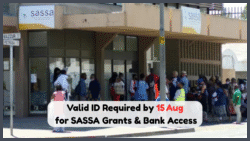R2 Billion Power Rescue Plan: South Africa is abuzz with discussions surrounding the government’s latest initiative to combat the ongoing energy crisis. With load shedding becoming an almost everyday occurrence, the announcement of a R2 billion investment into a power rescue plan has sparked a wave of optimism and skepticism alike. This significant financial injection is aimed at addressing the persistent electricity shortages that have plagued the nation for years. As South Africans eagerly await the details of this ambitious venture, the question on everyone’s mind is whether this plan will finally bring the relief that has long been promised.

South Africa’s Energy Crisis: The Role of the R2 Billion Plan
As South Africa grapples with frequent power cuts, the introduction of the R2 billion power rescue plan comes at a critical juncture. Eskom, the national electricity provider, has struggled to meet demand due to aging infrastructure, maintenance failures, and financial constraints. This has resulted in widespread load shedding, causing disruptions in daily life and economic losses. The government has thus committed this substantial sum in hopes of revitalizing the energy sector. The plan is expected to focus on upgrading infrastructure, investing in renewable energy sources, and exploring innovative solutions to improve grid stability. By addressing these key issues, the government aims to create a more reliable power supply that can support economic growth and improve the quality of life for millions of South Africans.
Potential Impacts of the R2 Billion Power Initiative on Load Shedding
The R2 billion power rescue plan is expected to have significant implications for the country’s energy landscape. One of the primary goals is to reduce the frequency and severity of load shedding by increasing the capacity and efficiency of the national grid. This could involve fast-tracking the development of renewable energy projects, such as solar and wind farms, which have the potential to provide sustainable and cost-effective energy solutions. Additionally, improving the existing infrastructure and addressing maintenance backlogs could enhance Eskom’s ability to deliver consistent power. While the immediate relief may not be felt overnight, the long-term benefits of such an investment could include greater energy security, reduced reliance on coal, and a transition towards a greener economy. However, the success of the plan will largely depend on effective implementation and management to ensure that the allocated funds are used efficiently and transparently.
Challenges Facing the Implementation of the R2 Billion Plan
Despite the potential benefits, the R2 billion power rescue plan faces several challenges that could hinder its success. One of the most significant obstacles is the country’s existing financial constraints, which may limit the scope and speed of implementation. Corruption and mismanagement have historically plagued large-scale projects in South Africa, raising concerns about the effective use of resources. Additionally, the complexity of overhauling the energy sector requires coordination among various stakeholders, including government bodies, private enterprises, and local communities. Resistance from vested interests in the coal industry, which remains a major energy source, could also pose a challenge to the transition towards renewable energy. These factors underscore the importance of strong governance, accountability, and stakeholder engagement in ensuring the plan’s success.
Public Reaction and Expectations of the R2 Billion Power Rescue Plan
The announcement of the R2 billion power rescue plan has elicited mixed reactions from the South African public. While many are hopeful that the initiative will bring much-needed relief from load shedding, others remain skeptical about its feasibility and potential outcomes. Previous efforts to address the energy crisis have often fallen short, leading to a sense of cautious optimism among the populace. Some citizens are concerned about the transparency of how the funds will be allocated and whether the benefits will be equitably distributed across all regions. Others are eager to see the government take decisive action to transition to renewable energy and reduce carbon emissions. Public expectations are high, and the success of the plan will be closely scrutinized by both citizens and industry experts. Ultimately, the government’s ability to deliver on its promises will determine whether this investment marks a turning point in South Africa’s energy saga.







